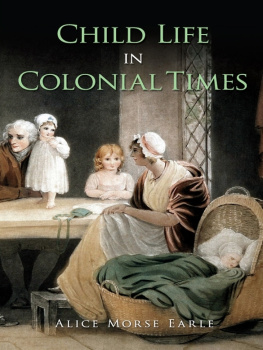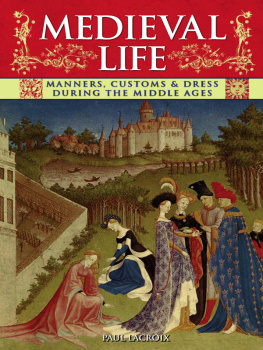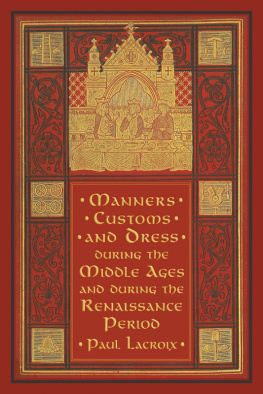Foreword
*
The illustrations for this book are in every case from real articles and scenes, usually from those still in existencerare relics of past days. The pictures are the symbols of years of careful search, patient investigation, and constant watchfulness. Many a curious article as nameless and incomprehensible as the totem of an extinct Indian tribe has been studied, compared, inquired and written about, and finally triumphantly named and placed in the list of obsolete domestic appurtenances. From the lofts of woodsheds, under attic eaves, in dairy cellars, out of old trunks and sea-chests from mouldering warehouses, have strangely shaped bits and combinations of wood, stuff, and metal been rescued and recognized. The treasure stores of Deerfield Memorial Hall, of the Bostonian Society, of the American Antiquarian Society, and many State Historical Societies have been freely searched; and to the officers of these societies I give cordial thanks for their coperation and assistance in my work.
The artistic and correct photographic representation of many of these objects I owe to Mr. William F. Halliday of Boston, Massachusetts, Mr. George F. Cook of Richmond, Virginia, and the Misses Allen of Deerfield, Massachusetts. To many friends, and many strangers, who have secured for me single articles or single photographs, I here repeat the thanks already given for their kindness.
There were two constant obstacles in the path: An article would be found and a name given by old-time country folk, but no dictionary contained the word, no printed description of its use or purpose could be obtained, though a century ago it was in every household. Again, some curiously shaped utensil or tool might be displayed and its use indicated; but it was nameless, and it took long inquiry and deduction,the faculty of "taking a hint,"to christen it. It is plain that different vocations and occupations had not only implements but a vocabulary of their own, and all have become almost obsolete; to the various terms, phrases, and names, once in general application and use in spinning, weaving, and kindred occupations, and now half forgotten, might be given the descriptive title, a "homespun vocabulary." By definite explanation of these terms many a good old English word and phrase has been rescued from disuse.
ALICE MORSE EARLE.
Chapter I - Homes of the Colonists
*
When the first settlers landed on American shores, the difficulties in finding or making shelter must have seemed ironical as well as almost unbearable. The colonists found a land magnificent with forest trees of every size and variety, but they had no sawmills, and few saws to cut boards; there was plenty of clay and ample limestone on every side, yet they could have no brick and no mortar; grand boulders of granite and rock were everywhere, yet there was not a single facility for cutting, drawing, or using stone. These homeless men, so sorely in need of immediate shelter, were baffled by pioneer conditions, and had to turn to many poor expedients, and be satisfied with rude covering. In Pennsylvania, New York, Massachusetts, and, possibly, other states, some reverted to an ancient form of shelter: they became cave-dwellers; caves were dug in the side of a hill, and lived in till the settlers could have time to chop down and cut up trees for log houses. Cornelis Van Tienhoven, Secretary of the Province of New Netherland, gives a description of these cave-dwellings, and says that "the wealthy and principal men in New England lived in this fashion for two reasons: first, not to waste time building; second, not to discourage poorer laboring people." It is to be doubted whether wealthy men ever lived in them in New England, but Johnson, in his Wonder-working Providence, written in 1645, tells of the occasional use of these "smoaky homes." They were speedily abandoned, and no records remain of permanent cave-homes in New England. In Pennsylvania caves were used by newcomers as homes for a long time, certainly half a century. They generally were formed by digging into the ground about four feet in depth on the banks or low cliffs near the river front. The walls were then built up of sods or earth laid on poles or brush; thus half only of the chamber was really under ground. If dug into a side hill, the earth formed at least two walls. The roofs were layers of tree limbs covered over with sod, or bark, or rushes and bark. The chimneys were laid of cobblestone or sticks of wood mortared with clay and grass. The settlers were thankful even for these poor shelters, and declared that they found them comfortable. By 1685 many families were still living in caves in Pennsylvania, for the Governor's Council then ordered the caves to be destroyed and filled in. Sometimes the settler used the cave for a cellar for the wooden house which he built over it.
These cave-dwellings were perhaps the poorest houses ever known by any Americans, yet pioneers, or poor, or degraded folk have used them for homes in America until far more recent days. In one of these miserable habitations of earth and sod in the town of Rutland, Massachusetts, were passed some of the early years of the girlhood of Madame Jumel, whose beautiful house on Washington Heights, New York, still stands to show the contrasts that can come in a single life.
The homes of the Indians were copied by the English, being ready adaptations of natural and plentiful resources. Wigwams in the South were of plaited rush or grass mats; of deerskins pinned on a frame; of tree boughs rudely piled into a cover, and in the far South, of layers of palmetto leaves. In the mild climate of the Middle and Southern states a "half-faced camp," of the Indian form, with one open side, which served for windows and door, and where the fire was built, made a good temporary home. In such for a time, in his youth, lived Abraham Lincoln. Bark wigwams were the most easily made of all; they could be quickly pinned together on a light frame. In 1626 there were thirty home-buildings of Europeans on the island of Manhattan, now New York, and all but one of them were of bark.
Though the settler had no sawmills, brick kilns, or stone-cutters, he had one noble friend,a firm rock to stand upon,his broad-axe. With his axe, and his own strong and willing arms, he could take a long step in advance in architecture; he could build a log cabin. These good, comfortable, and substantial houses have ever been built by American pioneers, not only in colonial days, but in our Western and Southern states to the present time. A typical one like many now standing and occupied in the mountains of North Carolina is here shown. Round logs were halved together at the corners, and roofed with logs, or with bark and thatch on poles; this made a comfortable shelter, especially when the cracks between the logs were "chinked" with wedges of wood, and "daubed" with clay. Many cabins had at first no chinking or daubing; one settler while sleeping was scratched on the head by the sharp teeth of a hungry wolf, who thrust his nose into the space between the logs of the cabin. Doors were hung on wooden hinges or straps of hide.











